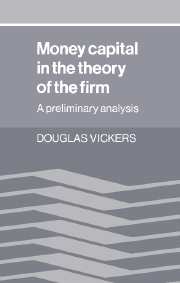Book contents
- Frontmatter
- Contents
- Preface
- PART I Theoretical issues and analytic motivation
- PART II The neoclassical tradition
- 4 Production, pricing, investment, and financing interdependence in the firm
- 5 Probability, risk, and economic decisions
- 6 Utility, uncertainty, and the theory of choice
- 7 Financial asset markets and the cost of money capital
- 8 The cost of money capital: further analysis and controversy
- 9 The investment expenditure project
- PART III Postclassical perspectives
- References
- Index
5 - Probability, risk, and economic decisions
Published online by Cambridge University Press: 18 September 2009
- Frontmatter
- Contents
- Preface
- PART I Theoretical issues and analytic motivation
- PART II The neoclassical tradition
- 4 Production, pricing, investment, and financing interdependence in the firm
- 5 Probability, risk, and economic decisions
- 6 Utility, uncertainty, and the theory of choice
- 7 Financial asset markets and the cost of money capital
- 8 The cost of money capital: further analysis and controversy
- 9 The investment expenditure project
- PART III Postclassical perspectives
- References
- Index
Summary
The question of risk or uncertainty has not yet been brought explicitly into our analysis. It has so far been incorporated only indirectly or in a proxy fashion. In our discussion of the risk exposure of the debt and equity holders in the firm, for example, we examined the impact on their positions of the degree of financial leverage in the firm's financing structure. But recent advances in the theory of the firm have attempted to handle the question of uncertainty in a more direct fashion. It has generally been assumed that the economic variables entering into the analysis could be interpreted as random variables that are describable by subjectively assigned probability distributions. It is risk in that sense that we shall discuss in this chapter. We shall be concerned with what has been called variability risk, or risk described by the degree of random disturbance in the economic variables that affect the operating results of the firm. An even more fundamental risk, that of the default, bankruptcy, and possible liquidation of the firm, has not been accorded as extensive a treatment.
In focusing on the variability risk, the decision maker has frequently been assumed to choose alternatives on the basis of a utility function defined over the possible profit, economic value, or rate of return that could be generated and the degree of risk involved. The risk, in turn, has been measured by the dispersion parameter of an appropriately defined probability distribution of outcomes.
- Type
- Chapter
- Information
- Money Capital in the Theory of the FirmA Preliminary Analysis, pp. 82 - 107Publisher: Cambridge University PressPrint publication year: 1987



